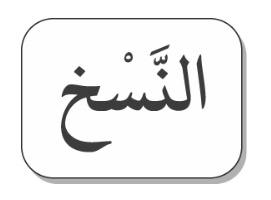Naskh Font
Definition
Naskh Font: It is the first of a group of computer fonts that are currently under production in King Fahd Glorious Qur’an Printing Complex in Madinah. It is a computer font that was built in accordance with the unified international coding “Unicode”, a global system that enables data to transfer across different systems and devices without displaying it in a distorted way, no matter how many companies that manufacture the systems and languages, and the countries through which this data passes.
With the support of Allah, this computer font was built and fully developed by the staff in the Research and Development Unit in the Information Technology Department at King Fahd Glorious Qur’an Printing Complex, through the following work stages:
Specifying the staff, studying and analyzing the project requirements, taking into account the many problems and errors that were discovered in the common Arabic computer fonts, including a number of well-known computer fonts, such as the Traditional Arabic font from Microsoft and Lotus font from Linotype and etc.
Preparing a timely, informed plan for the implementation and review stages, and implementing the amendments and improvements that are proposed during the examination and audit stages.
Writing single letters and all other combinations by the calligrapher of al-Madinah al-Nabawiyyah Musḥaf, Shaikh ‘Uthmān Ṭaha.
Commencing the programming work by specialized programmers, under the supervision and review of the calligrapher of the Musḥaf.
Launching the first experimental version of Alpha, and making it available for use within KFGQPC, as well as collecting, considering and refining notes and suggestions, and implementing the appropriate ones.
Launching the first version and making it available for download from the website dedicated to the computer fonts of the King Fahd Glorious Qur’an Printing Complex.
Key Features
The Naskh font is distinguished from many other computer fonts by the following:
A- The beauty of the font and its combinations.
ب- روعي فيه تطبيق عدد من القواعد المتعارف عليها في الخط العربي
• Taking into account writing the letter (ع) - followed by the letter (أ) or the letter (ل) - in the optimal way according to the following shape:
والتي تُكتب في الخطوط الحاسوبية الأخرى
• مراعاة طريقة كتابة السِنَن وتراكيبها المختلفة حسب ترتيبها في الكلمة الواحدة، فمثلاً عند كتابة كلمةٍ فيها سِنَّتان متتاليتان أو أكثر، يُراعى التمييز بين السنن حتى لا تظهر كسنن حرف السين
• كما روعي أيضاً شكل السنن التي تلي حرف اللام مباشرة
وكذلك أيضاً روعي شكل السِنَّة التي تسبق حرف الراء
و تظهر الأحرف المذكورة بالشكل التالي في كثير من الخطوط الأخرى
• مراعاة المحافظة على الشكل الطبيعي لحرف (اللام ألف) عند وضع تشكيل على حرف اللام، فتكتب
وليس كما تظهر في بعض الخطوط الأخرى
• استخدام شكل حرف الهاء المفردة التي تستخدم في الدلالة على السَّنَة عند كتابة التاريخ الهجري بدون الحاجة إلى إدراجها رمزاً
• تحديد مواضع التشكيل للأحرف والكلمات بدقة

